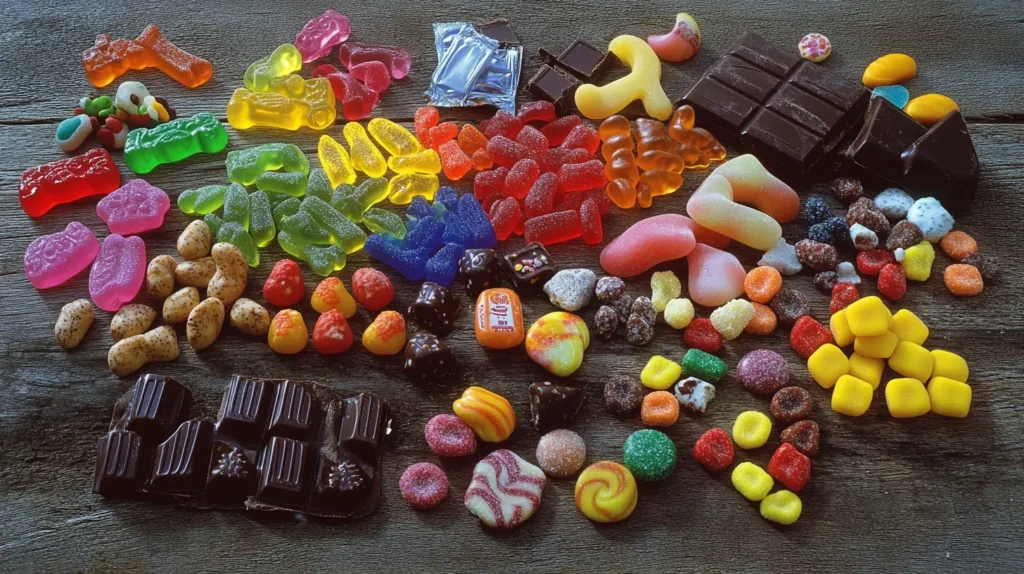Candy is a beloved indulgence for people of all ages, often associated with celebrations, childhood nostalgia, and moments of simple pleasure. However, unhealthy candies—those exceptionally high in sugar, calories, artificial additives, or harmful fats—pose significant risks to health when consumed in excess. These treats can lead to weight gain, tooth decay, and long-term issues like diabetes and heart disease. Understanding which candies are most detrimental empowers consumers to make informed choices while still enjoying occasional sweet indulgences.

Unhealthy candies can have significant negative effects on the body. Regular consumption of such treats may lead to issues like weight gain, tooth decay, blood sugar spikes, and even long-term complications such as diabetes and heart disease. Understanding which candies are the most detrimental to health can empower consumers to make more informed choices without entirely giving up on their sweet cravings.
This discussion delves into the factors that make certain Unhealthy candies unhealthier than others, exploring their nutritional pitfalls, and highlights examples of candies that top the “unhealthiest” list. Whether you’re a parent trying to limit your child’s sugar intake or an adult looking to make smarter snacking choices, this exploration aims to provide valuable insights into the world of candy and its impact on health.
Table of Contents
Understanding Candy and Its Ingredients

Candy, in its many forms, is a product of creative culinary chemistry, designed to delight our taste buds. While the variety of Unhealthy candies available is nearly endless, their basic composition shares several core ingredients. Understanding these ingredients and their effects is essential to grasp why some candies are considered unhealthier than others.
1. Sugar: The Primary Culprit
Sugar is the cornerstone of most candies, providing sweetness and energy. Whether derived from cane, beets, or corn (as high fructose corn syrup), sugar is added in large quantities to achieve the desired taste. While it’s a quick source of energy, excessive sugar intake is linked to numerous health issues, including obesity, diabetes, and dental cavities.
2. Artificial Additives
To make candies more appealing, manufacturers often use artificial colorings, preservatives, and flavorings. These chemicals enhance visual and taste appeal but can pose risks. For instance:
- Artificial colorings like Red 40 or Yellow 5 have been associated with hyperactivity in children.
- Preservatives such as BHT (Butylated Hydroxytoluene) may have potential carcinogenic effects when consumed in large amounts.
3. Fats
Unhealthy candies with rich chocolate or creamy fillings often come packed with harmful fats, including trans fats and saturated fats. These fats improve the taste but contribute to long-term risks like heart disease when consumed excessively.
4. Flavorings
Natural or synthetic flavorings are used to replicate everything from fruity to nutty profiles. While generally recognized as safe, some synthetic flavorings may trigger allergies or sensitivities in certain individuals.
5. Other Ingredients
- Corn Syrup: A cheaper alternative to sugar, this ingredient is high in fructose and contributes to insulin resistance.
- Gelatin: Found in gummies and marshmallows, it gives Unhealthy candies their chewy texture but offers minimal nutritional value.
- Acids: Citric or malic acids are added to provide tartness, especially in sour candies, but they can erode tooth enamel over time.
While these ingredients work together to make candy irresistible, they also highlight why moderation is essential, especially when it comes to unhealthy candies. Understanding the specific components in these sugary treats helps reveal why some are worse for your health than others. By identifying the harmful additives and excessive sugar in unhealthy sweet treats, consumers can make smarter choices and enjoy candy responsibly without compromising their well-being.
Nutritional Value of Popular Candies
Not all candies are created equal when it comes to nutritional content. Popular brands of unhealthy Unhealthy candies vary significantly in calorie counts, sugar levels, fat content, and the presence of artificial additives. Understanding the nutritional profile of these sugary treats is essential to make more informed choices and to identify which unhealthy sweet treats may pose the greatest health risks. By being aware of these factors, consumers can better manage their candy consumption and reduce potential negative impacts on their health.
1. Calorie Counts
Caloric content is one of the primary indicators of a candy’s energy contribution, but higher calorie counts often mean more sugar and fat. Many unhealthy candies, such as Snickers or Reese’s Peanut Butter Cups, pack a significant number of calories into small portions. These calorie-dense confections not only contribute to excessive sugar intake but also contain harmful fats, making them a less favorable choice for health-conscious individuals. Understanding the calorie and sugar content of unhealthy sweet treats can help consumers make informed decisions.
- Snickers (44g bar): Approximately 250 calories. Contains peanuts, nougat, and caramel, making it higher in fat and protein compared to sugar-based Unhealthy candies.
- Reese’s Peanut Butter Cups (2 cups): About 220 calories. These contain significant amounts of both sugar and fat due to the chocolate and peanut butter.
- Skittles (2 oz bag): Around 250 calories. Purely sugar-based with no fat, Skittles derive their calories entirely from carbohydrates.
2. Sugar Content
Excessive sugar intake is a hallmark of most unhealthy candies. Popular options often far exceed the recommended daily limit of added sugars, making them a significant contributor to health issues. Unhealthy sweet treats like Twix or M&Ms are loaded with sugar, providing little to no nutritional value. Consuming these sugary confections regularly can lead to weight gain, blood sugar spikes, and long-term health risks, including diabetes and heart disease. Recognizing the dangers of sugar-loaded Unhealthy candies is crucial for making smarter dietary choices.
- Twix (2 bars): 24g of sugar. The combination of caramel and chocolate contributes to its sweetness.
- M&Ms (1.69 oz bag): 31g of sugar, mostly from the candy shell and chocolate core.
- Sour Patch Kids (2 oz bag): A staggering 40g of sugar, with the added concern of acidic components that can erode tooth enamel.
3. Fat Content
While sugar dominates the candy landscape, some candies also contain significant amounts of unhealthy fats:
- Butterfinger (1 bar): 11g of fat, much of it saturated, due to its peanut butter and chocolate composition.
- KitKat (1 package, 4 fingers): 11g of fat, including both saturated and trans fats from palm oil and cocoa butter.
- Plain Hershey’s Chocolate Bar (43g): 13g of fat, mostly from cocoa butter.
4. Additives and Artificial Ingredients
Many candies include preservatives, artificial colorings, and flavorings that, while safe in moderation, may be concerning when consumed excessively:
- Starburst: Brightly colored and intensely flavored, these Unhealthy candies rely on artificial dyes (Yellow 5, Red 40) and flavoring agents.
- Jelly Belly Jelly Beans: These use both artificial and natural flavors, with added shine from a resin called shellac.
The Role of Sugar in Candy
Sugar is the cornerstone of most candies, responsible for their signature sweetness and addictive appeal. It serves multiple purposes in candy recipes, from enhancing flavor to contributing to texture and preservation. However, its prevalence also poses significant health risks, especially when consumed in excess.
How Sugar Dominates Candy Recipes
- Sweetness and Flavor
Sugar is the primary ingredient in candies because it delivers the intense sweetness that people crave. Different types of sugar, such as granulated sugar, high fructose corn syrup, or glucose syrup, are used depending on the desired taste and texture. - Texture and Structure
In chewy candies like caramels or gummies, sugar is heated to high temperatures, creating the sticky and pliable textures people enjoy. In hard Unhealthy candies, sugar is boiled to create a glass-like structure. - Preservation
Sugar acts as a natural preservative by reducing the moisture content in candies, preventing microbial growth and extending shelf life. - Visual Appeal
Sugar is often combined with artificial colorings and coatings to make candies visually enticing, especially to children.
Health Effects of Excessive Sugar Consumption
- Immediate Effects
- Blood Sugar Spikes: Sugary candies are quickly absorbed into the bloodstream, causing rapid blood sugar elevation followed by an energy crash. This can lead to cravings for more sugar.
- Tooth Decay: Sugar feeds harmful bacteria in the mouth, leading to acid production that erodes enamel and causes cavities.
- Long-Term Effects
- Obesity: Sugary candies are calorie-dense and can contribute to weight gain when consumed regularly.
- Diabetes: Over time, excessive sugar consumption can lead to insulin resistance, increasing the risk of Type 2 diabetes.
- Heart Disease: High sugar intake is linked to increased triglycerides, a risk factor for heart disease.
- Behavioral and Cognitive Impacts
- Children and Hyperactivity: While evidence is mixed, some studies suggest that sugar may exacerbate hyperactivity in sensitive individuals.
- Mood Swings: Sugar crashes can lead to irritability and difficulty concentrating.
Why Is Sugar So Addictive?
Sugar stimulates the brain’s reward system by releasing dopamine, creating feelings of pleasure. This can lead to cravings and a cycle of overconsumption. The addictive nature of sugar is why it dominates not only Unhealthy candies but also other processed foods.
Identifying the “Unhealthiest” Candy
Labeling a candy as the “unhealthiest” involves evaluating its nutritional content and the potential risks associated with its ingredients. While candy is generally considered a treat meant for occasional consumption, some varieties stand out as particularly detrimental due to their composition. Here are the key criteria used to determine the unhealthiest candies.
1. High Sugar Content
The most common characteristic of unhealthy Unhealthy candies is an exceptionally high sugar content.
- Impact on Health:
- Excessive sugar consumption can lead to weight gain, blood sugar spikes, and a higher risk of developing Type 2 diabetes.
- Candies with high sugar levels, especially those consumed frequently, contribute to tooth decay and cavities.
- Examples: Hard candies and sour candies, such as Sour Patch Kids or Skittles, often contain more than 40 grams of sugar per serving.
2. High Calorie Density
Candies that pack a large number of calories into a small serving size are also considered unhealthy.
- Impact on Health:
- High-calorie density contributes to overconsumption, which can lead to obesity and other related health issues.
- Examples: Candy bars like Snickers and Butterfinger, which contain around 250–300 calories per serving.
3. Harmful Fats
The presence of trans fats or excessive amounts of saturated fats makes a candy particularly unhealthy.
- Impact on Health:
- Trans fats are linked to an increased risk of heart disease.
- Saturated fats, when consumed in large quantities, can raise cholesterol levels.
- Examples: Chocolate-based Unhealthy candies like Reese’s Peanut Butter Cups and Twix, which combine fats from cocoa butter, palm oil, and other sources.
4. Artificial Additives
The inclusion of synthetic colorings, flavorings, and preservatives can raise concerns about a candy’s safety.
- Impact on Health:
- Artificial colorings like Red 40 and Yellow 5 have been linked to behavioral issues in children and potential allergic reactions.
- Preservatives such as BHT may have long-term carcinogenic effects in high quantities.
- Examples: Brightly colored gummies, jellybeans, and sour Unhealthy candies often contain a cocktail of artificial additives.
5. Low Nutritional Value
Candies that offer little to no nutritional value, such as protein, fiber, or vitamins, are considered less healthy.
- Impact on Health:
- These “empty calories” provide energy without any beneficial nutrients, making them easy to overeat and unsatisfying in the long term.
- Examples: Sugary confections like Candy Corn or Marshmallows, which consist almost entirely of sugar and artificial flavoring.
6. Acidity and Enamel Erosion
Sour candies, known for their tangy taste, often contain high levels of acids like citric and malic acid.
- Impact on Health:
- These acids can erode tooth enamel, especially when combined with high sugar content.
- Examples: Candies like Warheads and Sour Patch Kids, which are both acidic and sugary.
Ranking the “Unhealthiest” Candy
A candy that combines multiple unhealthy traits—high sugar and calorie content, harmful fats, artificial additives, and low nutritional value—is likely to be ranked among the unhealthiest. Examples include:
- Sour Patch Kids: Extremely high in sugar and acidity, leading to tooth decay and enamel erosion.
- Butterfinger: High in calories, sugar, and saturated fat, making it a triple threat.
- Skittles: Pure sugar with artificial colorings and no nutritional benefits.
Frequently Asked Questions (FAQs)
1. What makes a candy “unhealthy”?
A candy is considered unhealthy when it is high in sugar, calories, or harmful fats while offering little to no nutritional value. The presence of artificial additives, preservatives, and dyes further contributes to its negative health impact. Candies that are acidic or sticky can also damage tooth enamel and lead to cavities.
2. Are sour candies worse for your teeth than regular candies?
Yes, sour candies are often worse for your teeth because they contain high levels of citric or malic acid, which can erode tooth enamel. When combined with high sugar content, these candies create a perfect environment for cavities and other dental problems.
3. What are “empty calories” in candies?
Empty calories refer to foods or beverages that provide energy (calories) but lack essential nutrients such as vitamins, minerals, or protein. Most candies fall into this category because they are primarily composed of sugar and fats without offering any significant health benefits.
4. How much sugar is too much in a candy?
The American Heart Association recommends no more than 25 grams of added sugar per day for women and 36 grams for men. Many candies exceed these limits in a single serving, making it easy to consume too much sugar unintentionally

Conclusion
Candy is a beloved indulgence enjoyed by people of all ages, but its impact on health cannot be ignored. Many popular candies are high in sugar, calories, unhealthy fats, and artificial additives, contributing to various health risks such as weight gain, tooth decay, and chronic diseases when consumed excessively. Identifying the unhealthiest candies involves understanding their nutritional profiles, ingredients, and the potential effects they have on the body.
While candy is not inherently harmful when enjoyed in moderation, making informed choices about the types of sweets consumed can help mitigate their negative impacts. Opting for treats with lower sugar and fat content, or choosing healthier alternatives like dark chocolate or natural fruit-based snacks, allows for enjoyment without compromising health.
Ultimately, awareness and moderation are key. By balancing candy consumption with a healthy lifestyle, you can savor these sweet treats while minimizing their potential downsides. Treat candy as an occasional indulgence rather than a dietary staple, and remember that small changes in your choices can have a big impact on overall well-being.
